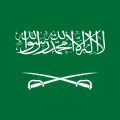This article includes a list of general references, but it lacks sufficient corresponding inline citations .(February 2017) |
| King of Saudi Arabia | |
|---|---|
| ملك المملكة العربية السعودية | |
 | |
| Incumbent | |
 | |
| Salman since 23 January 2015 | |
| Details | |
| Style | The Custodian of the Two Holy Mosques |
| Heir presumptive | Mohammad bin Salman Al Saud |
| First monarch | Saud I |
| Formation | 1720 |
| Residence | Al-Yamamah Palace (Riyadh) Al-Safa Palace (Mecca) Al-Salam Palace (Jeddah) Tayibah Palace (Medina) Al-Aziziya Palace (Dammam) |
| Website | https://houseofsaud.com/ |
 |
|---|
|
| Basic Law |

This is a list of rulers of Saudi Arabia , a kingdom on the Arabian Peninsula.


















